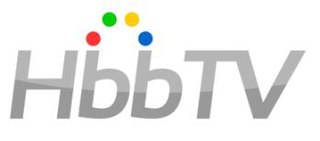Related Research Articles
Telecommunications in Ireland operate in a regulated competitive market that provides customers with a wide array of advanced digital services. This article explores Ireland's telecommunications infrastructure including: fixed and mobile networks, The voice, data and Internet services, cable television, developments in next generation networks and broadcast networks for radio and television.

Digital Video Broadcasting (DVB) is a set of international open standards for digital television. DVB standards are maintained by the DVB Project, an international industry consortium, and are published by a Joint Technical Committee (JTC) of the European Telecommunications Standardisé Institute (ETSI), European Committee for Electrotechnical Standardization (CENELEC) and European Broadcasting Union (EBU).
DVB-T, short for Digital Video Broadcasting — Terrestrial, is the DVB European-based consortium standard for the broadcast transmission of digital terrestrial television that was first published in 1997 and first broadcast in Singapore in February, 1998. This system transmits compressed digital audio, digital video and other data in an MPEG transport stream, using coded orthogonal frequency-division multiplexing modulation. It is also the format widely used worldwide for Electronic News Gathering for transmission of video and audio from a mobile newsgathering vehicle to a central receive point. It is also used in the US by Amateur television operators.
Integrated Services Digital Broadcasting is a Japanese broadcasting standard for digital television (DTV) and digital radio.

Advanced Television Systems Committee (ATSC) standards are an American set of standards for digital television transmission over terrestrial, cable and satellite networks. It is largely a replacement for the analog NTSC standard and, like that standard, is used mostly in the United States, Mexico, Canada, and South Korea. Several former NTSC users, in particular Japan, have not used ATSC during their digital television transition, because they adopted their own system called ISDB.
Digital radio is the use of digital technology to transmit or receive across the radio spectrum. Digital transmission by radio waves includes digital broadcasting, and especially digital audio radio services.
Digital terrestrial television is a technology for terrestrial television in which land-based (terrestrial) television stations broadcast television content by radio waves to televisions in consumers' residences in a digital format. DTTV is a major technological advance over the previous analog television, and has largely replaced analog which had been in common use since the middle of the 20th century. Test broadcasts began in 1998 with the changeover to DTTV beginning in 2006 and is now complete in many countries. The advantages of digital terrestrial television are similar to those obtained by digitising platforms such as cable TV, satellite, and telecommunications: more efficient use of limited radio spectrum bandwidth, provision of more television channels than analog, better quality images, and potentially lower operating costs for broadcasters.

Malaysian television broadcasting was introduced on 28 December 1963. Colour television was introduced on 28 December 1978. Full-time colour transmissions were officially inaugurated on New Year's Day 1982. There are currently 18 national free-to-air terrestrial television stations in Malaysia and 2 national pay subscription television stations in Malaysia.
DVB-H is one of three prevalent mobile TV formats. It is a technical specification for bringing broadcast services to mobile handsets. DVB-H was formally adopted as ETSI standard EN 302 304 in November 2004. The DVB-H specification can be downloaded from the official DVB-H website. From March 2008, DVB-H is officially endorsed by the European Union as the "preferred technology for terrestrial mobile broadcasting". The major competitors of this technology are Qualcomm's MediaFLO system, the 3G cellular system based MBMS mobile-TV standard, and the ATSC-M/H format in the U.S. DVB-SH now and DVB-NGH in the future are possible enhancements to DVB-H, providing improved spectral efficiency and better modulation flexibility. DVB-H has been a commercial failure, and the service is no longer on-air. Ukraine was the last country with a nationwide broadcast in DVB-H, which began transitioning to DVB-T2 during 2019.
Multimedia Broadcast Multicast Services (MBMS) is a point-to-multipoint interface specification for existing 3GPP cellular networks, which is designed to provide efficient delivery of broadcast and multicast services, both within a cell as well as within the core network. For broadcast transmission across multiple cells, it defines transmission via single-frequency network configurations. The specification is referred to as Evolved Multimedia Broadcast Multicast Services (eMBMS) when transmissions are delivered through an LTE network. eMBMS is also known as LTE Broadcast.

Mobile television is television watched on a small handheld or mobile device. It includes service delivered via mobile phone networks, received free-to-air via terrestrial television stations, or via satellite broadcast. Regular broadcast standards or special mobile TV transmission formats can be used. Additional features include downloading TV programs and podcasts from the Internet and storing programming for later viewing.
DVB-SH is a physical layer standard for delivering IP based media content and data to handheld terminals such as mobile phones or PDAs, based on a hybrid satellite/terrestrial downlink and for example a GPRS uplink. The DVB Project published the DVB-SH standard in February 2007.
DVB-T2 is an abbreviation for "Digital Video Broadcasting — Second Generation Terrestrial"; it is the extension of the television standard DVB-T, issued by the consortium DVB, devised for the broadcast transmission of digital terrestrial television. DVB has been standardized by ETSI.
High-definition television describes a television system providing a substantially higher image resolution than the previous generation of technologies. The term has been used since 1936, in more recent times it refers to the generation following standard-definition television (SDTV), often abbreviated to HDTV or HD-TV. It is the current de facto standard video format used in most broadcasts: terrestrial broadcast television, cable television, satellite television and Blu-ray Discs.
In Thailand, television broadcasting started on 24 June, 1955. Color telecasts were started in 1967, and full-time color transmissions were launched in 1975. As of November 2020, there are currently 21 digital (DVB-T2) TV channels in Thailand.
EchoStar Mobile, an Irish company with commercial operations headquartered in the United Kingdom and a data centre based in Griesheim, Germany, is a mobile operator that provides connectivity across Europe through a converged satellite and terrestrial network. EchoStar Mobile is a subsidiary of EchoStar Corporation, a provider of satellite communications devices.

Hybrid Broadcast Broadband TV (HbbTV) is both an industry standard and promotional initiative for hybrid digital TV to harmonise the broadcast, IPTV, and broadband delivery of entertainment to the end consumer through connected TVs and set-top boxes. The HbbTV Association, comprising digital broadcasting and Internet industry companies, has established a standard for the delivery of broadcast TV and broadband TV to the home, through a single user interface, creating an open platform as an alternative to proprietary technologies. Products and services using the HbbTV standard can operate over different broadcasting technologies, such as satellite, cable, or terrestrial networks.

Digital multimedia broadcasting (DMB) is a digital radio transmission technology developed in South Korea as part of the national IT project for sending multimedia such as TV, radio and datacasting to mobile devices such as mobile phones, laptops and GPS navigation systems. This technology, sometimes known as mobile TV, should not be confused with Digital Audio Broadcasting (DAB) which was developed as a research project for the European Union.
References
- ↑ DVB – Digital Video Broadcasting – Italy
- ↑ DVB - Digital Video Broadcasting - World's first commercial DVB-H service launched
- ↑ Hiwire Selects RRD USA Platform Delivery System to Deliver Mobile TV Channel Lineup
- ↑ "Archived copy". Archived from the original on 2007-07-16. Retrieved 2008-03-18.
{{cite web}}: CS1 maint: archived copy as title (link)